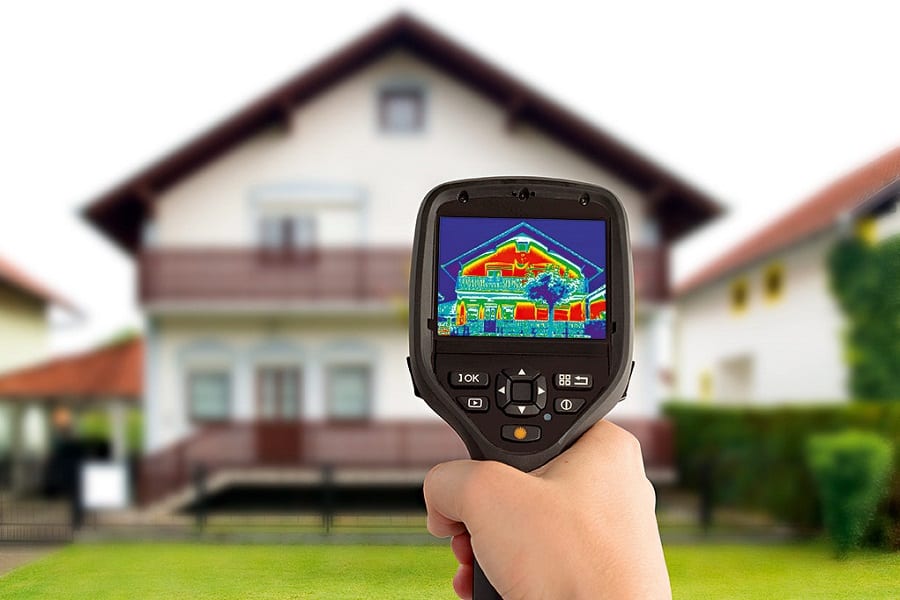You’ve purchased that new TV mount, and now it’s time to pin it to the wall.
The wife is asking you to finally hang those shelves up. Perhaps you’re trying to open up the wall and create a more open floor plan.
Whatever the case is, you’re not going to be able to do it without a stud finder.
We don’t want to rip out sheetrock, we don’t want to cause more damage than is needed—we just want to get the job done with as little of a headache as possible.
That’s what stud finders are for. We’ve broken down the top five stud finders on the market, from depth readings to user interface and everything in between.
Handling, battery usage and warranty have all been put into consideration.
You want to get your house in order, so it’s time to get your toolbox in order first, with the best stud finders on the market.
Best Stud Finders For 2020
Best overall – Stanley 200 Stud Sensor
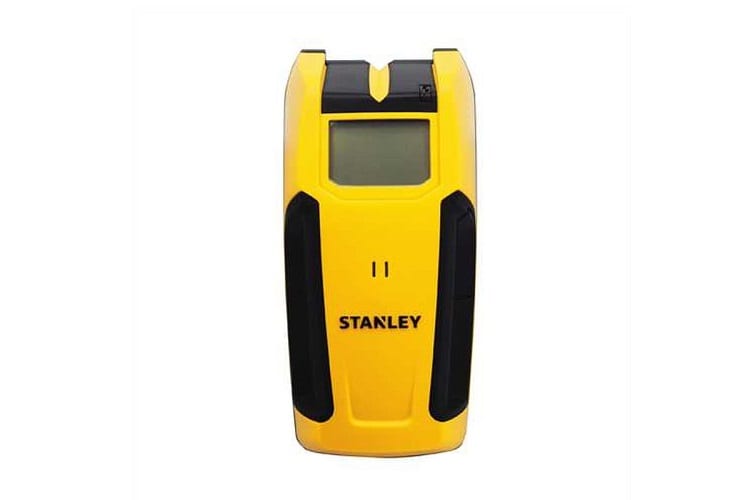
When you’re looking for stud finder reviews, you’re going to run into Stanley (along with reviews on any other tool out there). Stanley did a fantastic job at staying between the best pricing guidelines, while still offering a ton of features that really push this stud finder to the next level.
You get up to ¾” surface material depth scanning, which is more than enough for the standard ½” thickness of msot drywall. This ensures you can get through the two layers of paint and any distance between the drywall and stud on the inside. When you’re trying to detect uncovered wires (AC), you have 2” of depth, which can really come in handy during a demo project.
Stanley incorporated their OnePass technology here, ensuring you won’t have to scan the same spot twice to get an accurate reading. It finds the center of the stud right away, so long as you don’t swipe it across your wall way too fast.
So where’s the downside to this budget-friendly, effective stud finder? The Stanley brand yellow fades quickly, so this is going to look pretty rough before long. The side grips don’t hold up as long as you’d expect, and while this only weighs 6.4 oz and isn’t slippery to the touch, it’s still something noteworthy to point out.
Last but not least, when the screen lights up, it’s not overly bright. Corners have to be cut somewhere to give this kind of a price, you know? It’s lit up just enough, and the battery life on this is years at a time off of a 9V battery. Overall, they’re the best pick, but we have a few others to show you before your mind’s made up.
| Size: | 6.0” x 2.25” x 10.0” |
| Weight: | 6.4 oz |
| Batteries: | 9V (not included) |
| Depth: | ¾” surface material, 2” wiring |
Runner up – Tavool Stud Finder Sensor Wall Scanner
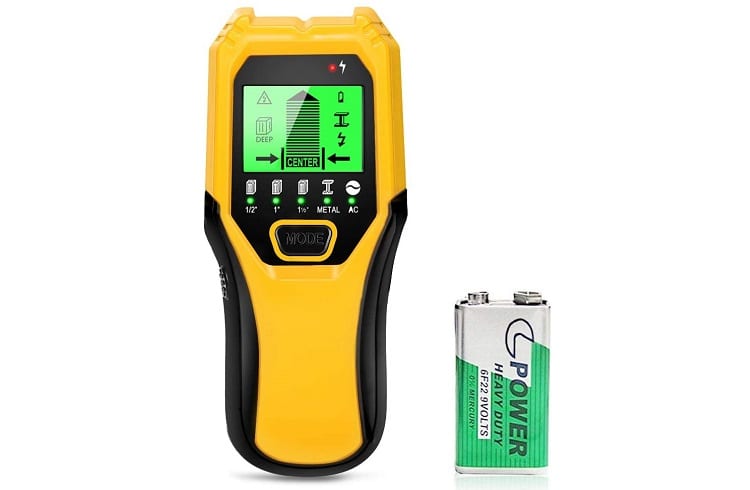
This thing is basically a Godsend for thick walls and hard demo projects, especially if you’re trying to find studs and wiring through brickl. Tavool comes with an impressive 1” surface material depth reading, and up to 2.3” on wiring.
So what is the best wall stud finder? Arguably one that allows you to have some versatility. Most of the world is using drywall, but there are other materials out there, like thick wall boards in cheaper construction homes. Tavool covers it all.
You have about a year of battery life on this through a 9V battery. The reason for that probably comes down to the hazard green display that lights up bright enough to leave you squinting. It’s very bright, and while that means you can see what you’re doing in low-light situations, it’s a bit much.
Now, there’s a bit of a caveat: Tavool lists 1” on surface material depth, but then states that it can detect studs up to 1.5” deep. There are five modes, three of which just detect studs, so it’s a bit gimmicky that they market it like it’s going to solve five separate problems. If you know that you have thin wall materials, you can use the lower setting to avoid detecting piping and wires deeper in the wall, but that’s about it.
Tavool makes this easy to use, and they keep the price nice and low. Not as low as Stanley, but it’s still going to save you a ton of money in the long run.
| Size: | 6.4” x 2.7” x 1.1” |
| Weight: | 9.4 oz |
| Batteries: | 9V (not included) |
| Depth: | 1.0” surface material, 2.3” wiring |
Alternative – VIVREAL 4-in-1 Stud Finder
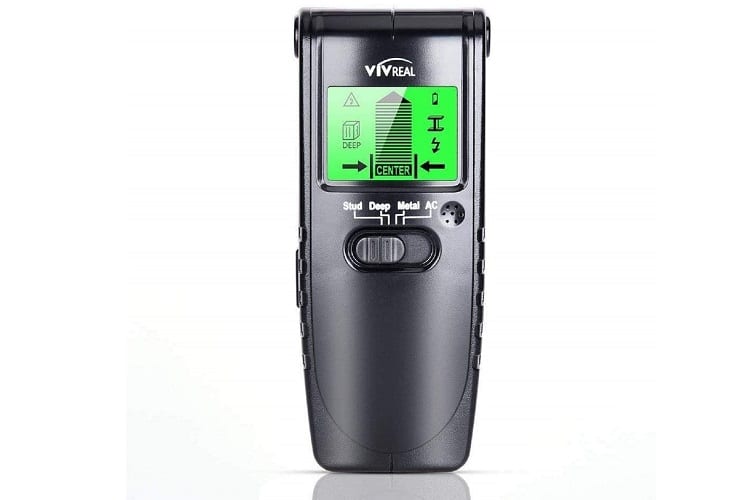
What makes VIVREAL one of the best professional stud finder models out there? Its ease of use. You want to be able to find the studs, get back to work, and then call it a day. VIVREAL gives you an ultra bright LCD screen (perhaps a bit too bright at times), so you’ll always have visibility.
As a 4-in-1 unit, you can detect AC wires, metal studs, exposed wires and wooden studs. This admittedly does a bit better on wiring than studs, though. You have a 0.5-0.75” depth for stud detection, which is also the average thickness of most drywall. This would be used to double-check and ensure you’re not pinning a nail through a bunch of live wires.
Now, there is a deep scan mode that allows you to see up to 1.5” through the wall, but that should be the default setting. It’s not 100% accurate, and comes across more like an added benefit or “boosted mode” rather than a primary feature.
The LCD screen displays where the center of the stud is, and there’s a convenient divot along the top so you can mark it with a pencil for drilling. Navigating the menu is easy enough, and despite being a low-resolution screen, it gets the center of the stud right on point every single time.
| Size: | 6.5” x 2.8” x 1.1” |
| Weight: | 5.4 oz |
| Batteries: | 9V (not included) |
| Depth: | 0.75” surface material, 2.0” wiring |
Alterantive – Zircon StudSensor e50
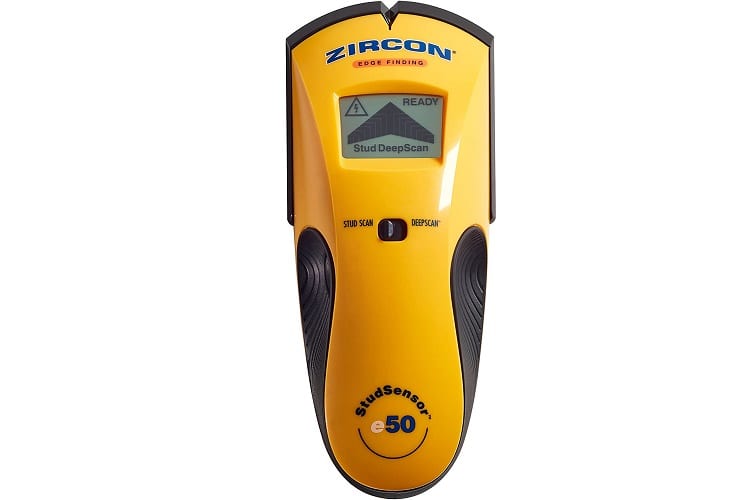
Zircon may not have taken the top spot in this quest to find the best stud sensor, but it still dishes out a ton of value for similar features to the likes of Stanley (and that same hazard yellow color).
Detect live AC wiring or studs with this simplified wall stud finder. There’s a divot along the top right in the center of its peak, so you can mark the center area of studs fairly easily.
This comes with a standard 0.75” depth mode, as well as up to 1.5” with the deep scan function. The reason that we’ve listed their depth as 0.75”, is because wall stud finders are supposed to be easy to use, and this is the maximum hands-free option that you have. Otherwise, you have to fidget with the settings, and it makes everything a bit more complicated.
With a wide operating temperature of 20°F up to 105°F, you can use this in the dead middle of summer, or even in the late fall/early winter if you’re working on a renovation project. That or, y’know, adding a media room to hunker down for the winter.
Like many things we buy, the batteries aren’t included here. You need an 9V to let this run, but be warned: it eats up battery like a vampire. I would recommend getting a four-pack of 9V batteries to start things off if I were you. While this provides reliable results, it does have a narrow detection zone.
| Size: | 8.5” x 4.0” x 2.0” |
| Weight: | 8.8 oz |
| Batteries: | 9V (not included) |
| Depth: | 0.75” surface material, 2.0” wiring |
Alterantive – Franklin Sensors ProSensor Professional Stud Finder
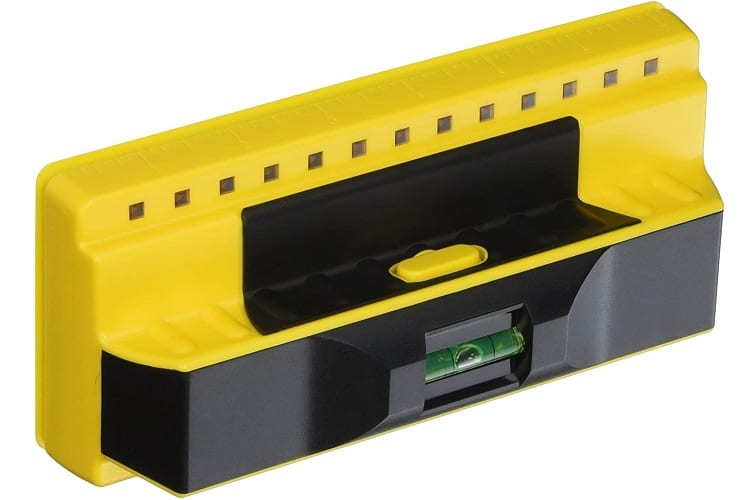
Last but not least, our fifth best wall scanner comes from Franklin Sensors. This ProSensor comes with a decent 0.75” depth, and up to 1.5” for metal and wiring through the wall. The funny thing is that this is one of the most expensive on this list despite not having the same range as Stanley and the other top dogs.
That’s partially because the physical build of this is a lot bulkier. You have a wider horizontal range that you can move this. The back end slides nice and smoothly against the wall, and comes with a leveling bubble so you know you’re making a straight plunge into the stud behind your wall material. There’s a built-in ruler, and that wide range we mentioned spans for 21” in total.
The bright yellow on this is going to wear away pretty fast, and while the bubble is nice, it should only be used if you don’t have a laser leveling tool handy. You have thirteen sensors in total that work during scanning, so you’re more than likely to find the stud you’re looking for.
The best part is that this comes completely calibrated out of the box, so you don’t have to mess with anything. That being said, there’s no way to adjust calibrations in the future. This thing will burn through the AAs that you need to run it, but it’s worth it for the power that you get.
| Size: | 7.5” x 3.0” x 2.7” |
| Weight: | 6.4 oz |
| Batteries: | Two AA batteries (not included) |
| Depth: | Between 0.75” and 1.5” across the board |
Stud Finder Buying Guide and FAQ
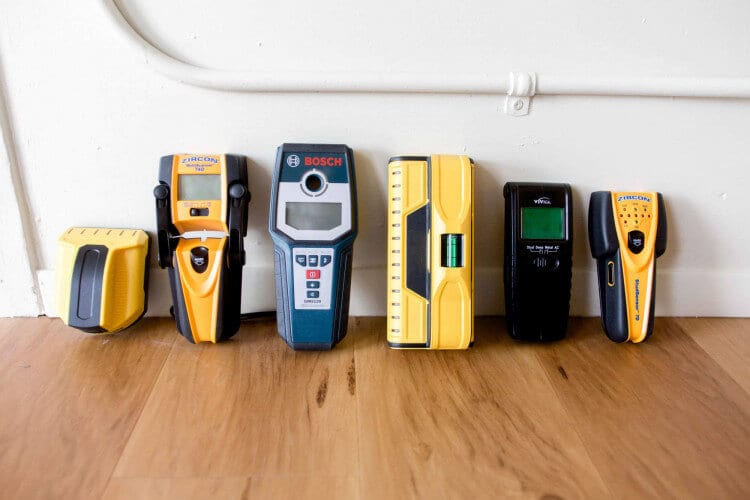
How Does a Stud Finder Work?
A stud detector isn’t like a mini X-ray machine—it detects changes in the dielectric pattern of the wall, which is altered by the presence of studs, pipes, and wiring.
An electric stud finder can detect what those changes are, and differentiate between the material you’re trying to find, if you set it on the right mode.
This changes what dielectric changes it’s looking for, which is why you can set it to AC wire detection, and it won’t find studs under those options.
While you’re not taking an X-ray of the wall, there are still electric sensors inside of your stud finder (more on this later).
Many stud finders have between half-a-dozen and fourteen sensors, giving you an accurate depiction of where the stud is.
It reads what sensors are detecting a change, which ones aren’t, and determines the edges of the studs by doing this.
Most studs have predetermined widths, which is beneficial for these stud finders in pinpointing the exact location of your studs.
Why do You Need a Stud Finder?
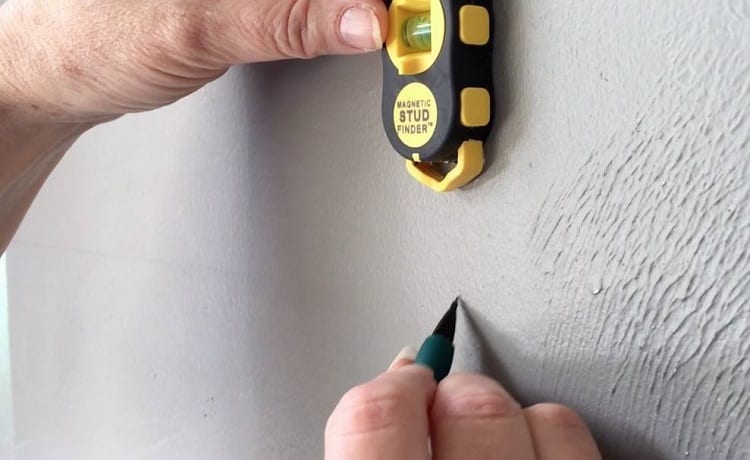
Hanging pictures and shelves are excellent ways to make more utility out of your walls, while also making your space more aesthetic.
Depending on what you’re hanging up, the weight of it, and how much weight you’re going to put on it, you might have to drill into a stud first.
Your drywall is strong enough to hold itself up, but have you ever bumped into the wall while moving furniture, or opened a door too harshly and dented or cracked the wall behind it?
It’s not designed to hold much, so if you want to hang shelves that can hold 30 lbs worth of items, the drywall is going to buckle.
Drilling into the stud, once you know its center, can offer more support for shelving and TV mounts, monitor mounts, and help you secure cabinets to the walls.
So now, you’ve got the top stud finder and you want to hang things up the right way. That’s good.
You can use it for mounting, as well as detecting studs to drill into the wall for new outlets, removing the drywall for remodels and expansions, and knowing where not to sink a nail when you’re hanging a picture, since stud finders can locate pipes and live AC wiring.
How Accurate Are Stud Finders?
The worrisome thing about using a stud finder is that you’re putting all of your faith into this little gadget. It’s important that it works, and that it can pinpoint studs. We don’t need estimates here.
If you have the best stud finder, one that has multiple detection methods and a high depth, you should be good.
Stud finders nowadays aren’t solely relying on magnetism, but instead relying on detecting dielectric changes in the wall, which prove to be more effective than just using magnets to find fasteners in the studs.
Many stud finders can accurately determine the difference between pipes, electrical conduits, and studs.
If your stud finder is detecting them at all, then it’s working fine. If it’s faulty, it neither won’t detect anything at all, or it will be stuck on a permanent detection, even if you remove it from the wall.
Why Shouldn’t You Use Your Smartphone as a Stud Finder?
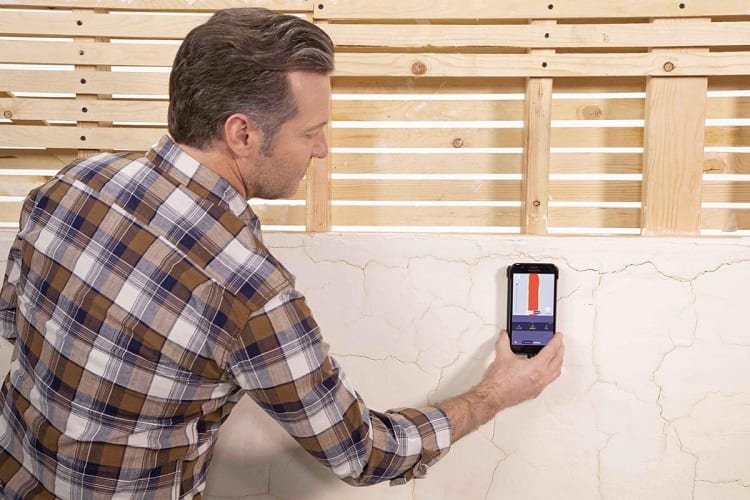
Let me ask you this: what is your smartphone capable of? Phone calls, social media posts, calculations, the works. Would you use it as a hammer? Or to drill a hole in the wall?
Apps are powerful, but they can’t do everything.
Your phone does not come with the necessary equipment to scan a wall for studs the way that a stud finder can.
There are some apps that work to a moderate degree, but these generally only actually find metal behind a wall at about 0.2”, which is 40% of the depth of your average piece of drywall. That’s not useful.
There’s a reason that most stud finders have a boosted mode that goes down to about 1.5” total depth, and smartphone apps do not.
Now, that being said, I’m not just here to completely bash phones. There is an attachment you can purchase that connects to the back of your phone, which connects to the micro USB port that you charge your phone from.
This is like an entire tool that attaches to your phone as a power source. It requires an app to run, but the power isn’t in the app.
All that says is that phone app wall stud detectors are cool to mess around with, but if you were to use one in a professional application, everyone around you would like at you as if you were nuts. It’s not practical.
Not to mention those attachments I mentioned usually end up costing you near a hundred dollars: enough to buy three or four standard stud detectors with superior range.
That, and it won’t suck the life out of your phone battery. I think we both know what the better option is here.
The Right Tool for the Job
Whether you’re mounting a television, or simply putting up some low-weight shelves, it’s important to know where your anchors should be.
The last thing you want is to pull out a big patch of drywall, only to find that there was nothing supporting it.
This is a tool that you’ll likely get ten to twenty years of use out of, making it a quintessential toolbox component for any handyman out there.







